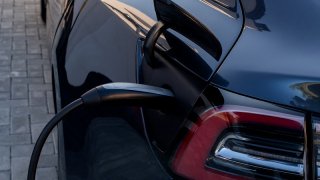In 2020, the number of registered new privately-owned cars were almost 103 000, of which 61 000 were electric. Purchase of electric cars add up to 59 per cent of all new car purchases. Information from the Ministry of Finance estimates that the collective tax benefit to electric cars was NOK 19,2 billion in 2020. We can quantify the relational differences between the purchase of electric cars and the households income by joining data from the register of vehicles from The public roads administration and Income and wealth statistics for households. Purchase of electric cars is more common in high-income households than in low-income households. Conclusively, the tax benefit has a socially skewed distribution.
The total amount of new registered passenger cars was 141 000 in 2020. Individuals owned approximately 104 000 of these by the end of the year. Another 1 000 cars are excluded as owned by institutional and student households in our data joining.
Households with high incomes buy more new cars than households with low incomes. Households in the group with of top 10 per cent income bought collectively 20 000 cars in 2020, of which 13 000 were electric. In comparison, households under average income collectively bought close to 27 000 cars, of which 14 000 were electric.
All income groups increased in the electric share of new cars purchased compared to 2018. Lower income groups increased the most. Only households in decile 2 with incomes between NOK 276 200 to 413 800 buy more fossil-fuel than electric cars, where the electric share is slightly underneath half. Among households in the group of of top 10 per cent income, 63 per cent of new cars purchased were electric. While among the households in the group of 10 per cent lowest income, 58 per cent of new cars purchased were electric. The share of electric cars among the households with lowest income have increased by 20 percentage points since 2018.
For 2020, we have used data from income data for 2019 and split households into deciles depending on the household’s collective income before tax. Figures in NOK. Bottom 10 per cent: under 276 200 10 - 20 per cent: 276 200 to 413 800 20 - 30 per cent: 413 800 to 551 000 30 - 40 per cent: 551 000 to 693 000 40 - 50 per cent: 693 000 to 851 200 50 - 60 per cent: 851 200 to 1 025 700 60 - 70 per cent: 1 025 700 to 1 218 800 70 - 80 per cent: 1 218 800 to 1 459 500 80 - 90 per cent: 1 459 500 to 1 854 300 Top 10 per cent: above 1 854 300
Greater inequality in Oslo
There are greater social inequalities to buying an electric car in the Urban area of Oslo is defined as the following municipalities: Oslo, Asker, Bærum, Nittedal, Nordre Follo, Lørenskog og Lillestrøm.. Households in the urban area Oslo bought 22 per cent of all new electric cars in Norway in 2020. Households in the group of top 10 per cent income group bought 29 per cent of new electric cars in the urban area Oslo. The same household income group bought 18 per cent of new electric cars in Norway without urban area Oslo. Also, the electric share of new cars is higher in urban area Oslo than in Norway without urban area Oslo. In the capital with environs, 68 per cent of new cars are electric. While in the rest of Norway, 57 per cent of new cars are electric.
Cheap electric cars are popular
The cheaper electric cars dominate electric car sales in 2020, both for households with lower income and households with higher income. Among the 25 per cent cheapest cars sold, 73 per cent were electric. While among the 25 per cent most expensive cars, 34 per cent were electric.
We have used car prices for November 2020 and split the registered new privately-owned cars into quartiles depending on the car’s estimated price. 25 per cent cheapest: under 369 700 25 - 50 per cent: 369 900 to 525 900 50 - 75 per cent: 526 100 to 862 400 25 per cent most expensive: above 862 400
The figures tell us that there are great differences in number of bought cars depending on household’s collective income. The figures also tell us that there has been an increase in the electric share of new cars bought by households with lower income. The explanation for the electric share increasing for households with lower income being higher quality in cheaper electric cars, simultaneously as Norwegian policy grants tax benefits to electric car owners.
Funded by the Ministry of Transport
